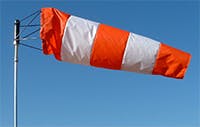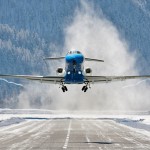St Jude Storm Warning – Why does wind affect flight?

Airports across the UK are braced for scheduled flight delays, disruption and cancellations on Monday 28 October 2013, as storm “St Jude” sweeps across England and Wales bringing high winds and heavy rain.
Here’s why wind can affect your private jet flight.
Strong winds and gusting conditions affect all aircraft especially during the taxi, take off and landing phases of the flight.
Technical Explanation of Lift
Aircraft fly because their wings create a lift force. This lift is created because the air flowing over the top of the wings is travelling faster than the air underneath the wings.
To create more lift, the aircraft has to fly faster (more air flows over the wings) or the pilot changes the shape of the wings (eg by putting flaps or slats out).
How does wind affect Lift?
A headwind allows more air to flow over the wings increasing lift. A tail wind will reduce the airflow and thus reduces lift.
An aircraft should always land into wind, as this allows the landing to be at a lower ground speed.
Cross Wind Limits
Every type of aircraft has a unique cross wind limit. A cross wind is the amount of wind at 90 degrees to the aircraft’s travelling direction.
When a runway is at 90 degrees to a strong wind, the aircraft may not be able to land and the pilot may decide to divert to another airport with a runway that points into wind.
Strong Gusting Winds affect landings
When an aircraft is landing into a strong headwind, if that wind suddenly drops or changes direction, the amount of air flowing over the aircraft may suddenly reduce. A sudden reduction in airflow results in less lift and a possible stall of the aircraft wings.
For these reasons strong and gusting winds may result in your flight being cancelled. A flight that has departed may have to divert to a new landing airport because of strong and gusting wind conditions.
Private jet travel during storms
Private flights are affected by high winds, heavy rain and storms as are scheduled airlines. A private jet pilot will always check the weather before and during your flight and only fly if it is safe.
However as private jets use smaller airports, which tend to be less affected by scheduled airline delays and disruption, private jets can generally start flying as soon as the weather is stable. Planned flight routes and airports can be changed en route or at short notice to avoid bad weather conditions.
Disruptions at main flight hubs such as Heathrow and Gatwick can have a knock-on affect for hours or even days after the event.
For private jet charter call us 24 hours on +44 (0) 1747 642 777.
Related content

What happens after you book a flight with PrivateFly?

Can a private jet fly in the snow?



